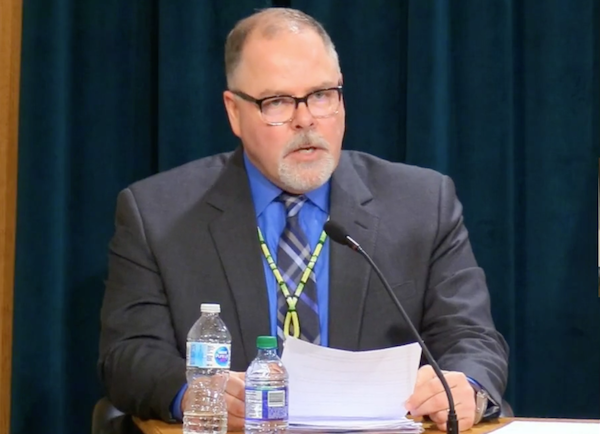The Saskatchewan Health Authority (SHA) is enforcing new measures to combat COVID-19 starting on Wednesday, including mandatory screening and continuous masking.
This is part of the health authority’s offensive strategy, which includes preventing community transmission. The defence includes ensuring health care services are available when needed.
SHA CEO Scott Livingstone provided an update on both on Tuesday.
He emphasized that it’s still planning based on the modelling projections released last week, which contains data from three scenarios: a low range of spread, mid range and high range. The high range scenario shows the province could see over 8,000 deaths from COVID-19.
However, as the SHA emphasized, this isn’t a prediction—it’s a set of ‘what-ifs’ so the province’s health care system is prepared for the worst that can happen.
“While we will continue to update the modelling numbers in the upcoming weeks, we continue our current path of planning for the worst and aiming for the best,” Livingstone told media.
The first new measure is mandatory screening, including temperature checks, for all health care workers within its facilities both before and after shifts. Additionally, all staff working directly with patients, clients and residents and those moving through care areas are required to wear procedure masks.
“These measures are about keeping our health care team safe and providing an additional layer of assurance to our patients, clients and residents who may be worried about asymptomatic workers.”
The SHA has also implemented new measures focusing on testing and contact tracing. Meadow Lake and Prince Albert are the first communities to receive expanded molecular testing.
These units provide results on site within about four hours, Premier Scott Moe explained in a news conference on Monday. The rapid results also allow for sooner contact tracing.
SHA Senior Medical Health Officer Dr. Julie Kryzanowski added that the testing is done in “small batches” and is being provided for priority populations.
Livingstone said the SHA will continue to expand this testing into rural and northern communities.
The province is hoping to process 1,500 tests per day by the end of April. The SHA averaged 780 tests a day last week, an increase of more than 24 per cent from the previous week.
Another measure the SHA is implementing to reduce community transmission is limiting the movement of health care workers between facilities.
“We hope to have strategies in place that will likely include a cohorting of staff,” said Livingstone, adding that a more definitive plan will be in place within a week or so.
“Today we have a number of staff that work in more than one facility. It approaches almost 20 per cent in long term care, as an example, so to be able to ensure that we’re not just protecting the people inside the facilities and the people that work inside those facilities, we need to ensure that we have the staff available to properly care for those folks.”
As of Tuesday, the province has seven people receiving inpatient care as a result of COVID-19-related illnesses. No one is in the Intensive Care Unit (ICU).
Despite this, said Livingstone, the SHA is still preparing its defensive strategy, which includes a potential spike in hospitalizations.
“Today, as an example, we have 50 per cent of the provincial available beds—without us actually putting more in place—are available today to care for patients as they require ICU care and we have over 1,000 acute care hospital beds available today to care for patients as they come in,” said Livingstone.
“The plan is still in place to significantly increase those services over the next few weeks and months as it’s required.”
Livingstone thanked Saskatchewan residents for practicing physical distancing, isolation and effective hand washing. He said the “key variable in saving lives” is the public complying to preventative measures.
“We know it hasn’t been easy. People are hurting personally and professionally—the emotional, mental, physical and economic realities of this becomes increasingly difficult with each passing week,” he said.
Livingstone said this compliance has slowed the spread of COVID-19 and allowed the health care system to prepare.
SHA says Sask. has about a month’s worth of PPE
Part of this preparation is having the proper personal protective equipment (PPE).
This week’s SHA Health System Readiness for COVID-19 update said Saskatchewan has about a month’s supply of PPE, including surgical masks, N95 respirators and gloves.
Livingstone said the SHA has had to order between four and six times the amount of PPE due to the pandemic. This is in addition to what it normally orders.
He said he doesn’t believe the continuous masking will deplete the supply, and that the SHA has been monitoring the province’s daily PPE use.
Last Thursday, the University of Saskatchewan announced its Vaccine and Infectious Disease Organization-International Vaccine Centre (VIDO-InterVac) partnered with the SHA to safely decontaminate and reuse N95 respiratory masks.
VIDO-InterVac successfully tested the decontamination process, vaporized hydrogen peroxide sterilization, on several dozen masks provided by the SHA. VIDO-InterVac Director Dr. Volker Gerdts said they’re ready to start decontaminating thousands of back-up masks if needed.
The announcement of these additional measures comes days after the Federation of Sovereign Indigenous Nations (FSIN) expressed concerns over the spread to Saskatchewan’s most isolated communities.
Northern First Nations said they would pursue legal action if the province and Saskatchewan and Athabasca Health Authorities don’t contain the infection, claiming a nurse is responsible for spreading the virus after travelling to Stony Rapids for work.


